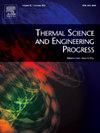Study on transformation characteristics and oxidation kinetics of coal spontaneous combustion induced by thermal radiation
IF 5.1
3区 工程技术
Q2 ENERGY & FUELS
引用次数: 0
Abstract
To investigate the thermal radiation effects on coal spontaneous combustion characteristics, this study conducted systematic experiments using a Laser Flash Apparatus and a self-built experimental platform for thermal radiation induction. The research systematically analyzed variations in multiple parameters including temperature, mass loss, gas emissions, surface morphology, and apparent activation energy of coal samples with distinct particle sizes under varying radiation intensities. The results demonstrated that the spontaneous combustion characteristics of coal depend on radiation temperature and particle size parameters. Under the combined effects of these factors, the time required to reach the maximum temperature point was reduced, accompanied by accelerating heating rates and increased mass loss. Furthermore, the oxygen adsorption capacity of coal was significantly enhanced, leading to a rapid increase in CO emission. Additionally, the surface layer of coal samples exhibited progressively severe drying, cracking, and collapsing phenomena. When the radiation temperature reached 250℃ with a coal particle size of 0.6 mm, the apparent activation energy is 18.8063 kJ·mol−1, accompanied by a pronounced change in the oxidation state of the coal. These findings hold significant implications for advancing the understanding of radiation-induced ignition mechanisms in adjacent coal within sealed fire zones and for the development of effective preventive measures.
热辐射诱导煤自燃的转化特性及氧化动力学研究
为了研究热辐射对煤自燃特性的影响,本研究利用激光闪燃仪和自建热辐射诱导实验平台进行了系统实验。系统分析了不同粒径煤样在不同辐射强度下的温度、质量损失、气体排放、表面形貌、表观活化能等参数的变化。结果表明,煤的自燃特性与辐射温度和粒径参数有关。在这些因素的共同作用下,达到最高温度点所需的时间缩短,同时加热速度加快,质量损失增加。煤对氧的吸附能力显著增强,导致CO排放量迅速增加。此外,煤样表层表现出逐渐严重的干燥、开裂和塌陷现象。当辐射温度达到250℃,煤粒度为0.6 mm时,表观活化能为18.8063 kJ·mol−1,煤的氧化态发生明显变化。这些发现对于推进对密封火区内相邻煤的辐射引燃机制的理解和制定有效的预防措施具有重要意义。
本文章由计算机程序翻译,如有差异,请以英文原文为准。
求助全文
约1分钟内获得全文
求助全文
来源期刊

Thermal Science and Engineering Progress
Chemical Engineering-Fluid Flow and Transfer Processes
CiteScore
7.20
自引率
10.40%
发文量
327
审稿时长
41 days
期刊介绍:
Thermal Science and Engineering Progress (TSEP) publishes original, high-quality research articles that span activities ranging from fundamental scientific research and discussion of the more controversial thermodynamic theories, to developments in thermal engineering that are in many instances examples of the way scientists and engineers are addressing the challenges facing a growing population – smart cities and global warming – maximising thermodynamic efficiencies and minimising all heat losses. It is intended that these will be of current relevance and interest to industry, academia and other practitioners. It is evident that many specialised journals in thermal and, to some extent, in fluid disciplines tend to focus on topics that can be classified as fundamental in nature, or are ‘applied’ and near-market. Thermal Science and Engineering Progress will bridge the gap between these two areas, allowing authors to make an easy choice, should they or a journal editor feel that their papers are ‘out of scope’ when considering other journals. The range of topics covered by Thermal Science and Engineering Progress addresses the rapid rate of development being made in thermal transfer processes as they affect traditional fields, and important growth in the topical research areas of aerospace, thermal biological and medical systems, electronics and nano-technologies, renewable energy systems, food production (including agriculture), and the need to minimise man-made thermal impacts on climate change. Review articles on appropriate topics for TSEP are encouraged, although until TSEP is fully established, these will be limited in number. Before submitting such articles, please contact one of the Editors, or a member of the Editorial Advisory Board with an outline of your proposal and your expertise in the area of your review.
 求助内容:
求助内容: 应助结果提醒方式:
应助结果提醒方式:


